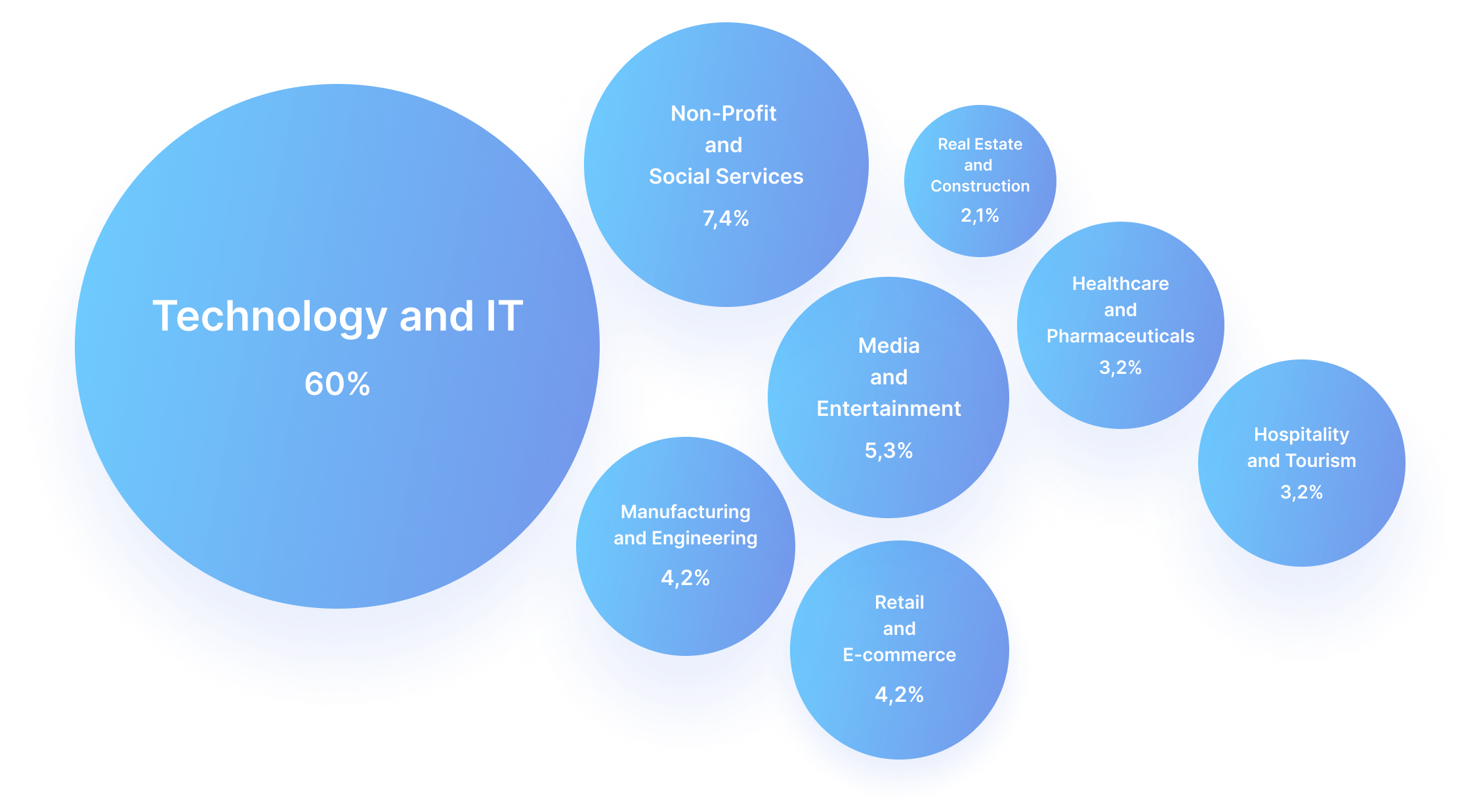
2023 State of the Company Offsite & Retreat
As remote and hybrid companies continue to gain ground in the months and years to come, company offsites and retreats become that much more essential for cultivating engagement, nurturing connections, and strengthening company culture.


Overview
We received and analyzed survey responses from people who planned a company offsite via Retreat, ChartHop, and Opsy, collecting a total of 100 responses on a first-come, first-served basis. Below is a breakdown of related details and company demographics.
Team Size Diversity: How big is your team?
95 responses

Various Industries: What's your company's primary industry focus?
95 responses

Company Remote Work Approaches
95 responses

Survey Respondent Job Titles: A Multitude of Roles
95 responses

2023 State of the Company Offsite & Retreat Report: Top Takeaways
Most companies hold offsites one to three times per year (on average).
Nevertheless, those that conduct over 10 events annually comprise 7.4% of total responses. Notably, 9.3% of fully remote companies and 5.1% of hybrid companies responded “More” with respect to annual event planning trends, indicating that offsites are in demand among companies of various structures—with notable adoption among those that are fully remote.
Annual Event Planning Trends
95 responses

Most surveyed companies conduct offsites with team-building as their primary goal.
In response to the question, “Which of the following did you plan?” 65.6% indicated “All-Hands” and 67.7% selected “Team Meeting.” Additionally, 2.2% mentioned “Regional Meeting,” involving remote teams gathering with colleagues in close proximity and thus indicating a growing interest in a new offsite style.
Event Type
93 responses

The annual budget assigned for offsites showed the highest percentage (18.9%) falls within the range of $100,001–$250,000.
When examining company sizes, 31.8% of companies with 10 or fewer employees had budgets of “Less than $10,000,” with “Less than $50,000” accounting for 59.1% overall. As company size rose to 51+ employees, budgets tended to rise as well: with “Over $100,000” comprising 45.2% of the total.
Annual Budget for Events
95 responses

This year, 8.4% of individuals planned their first offsite.
In contrast to last year (when 34.2% were first-timers), many survey respondents are now experienced planners: 82.1% of whom independently manage the planning process in the absence of third-party services.
Planning Experience: Is This Your First Time Planning?
95 responses

Independent Event Organization: A Yes or No Question
95 responses

The most common duration for offsites is 3 days and 2 nights, accounting for 45.3% of the total.
The majority (29.5%) allocate a budget of $1,001–$2,000 per person for a single offsite, suggesting an average daily per-person budget of approximately $400. Additionally, the most frequently used hotel budget per person/per night falls within the $150–$200 range (representing 38.3% of cases). Notably, 54.3% of cases allocate a budget of $250 or more (equivalent to 4-star hotels).
Duration: What was length of event?
95 responses

Offsite Budget: What was the budget per person on the last offsite? (including hotels flights ect)
95 responses

Hotel Budget: What was the hotel budget per person/night?
95 responses

How long in advance did you plan?
95 responses

What percentage attended the offsite?
95 responses

The most popular month for offsite events
95 responses

Which are the factors to decide the dates?
95 responses

Most Popular Countries for Offsite Destinations
The most popular countries
95 responses
The most popular country for offsite destinations is the United States, accounting for 66.4%. Following closely are Spain (4.4%) and Portugal (3.5%). Within the United States, California is the most favored at 28.6%, with New York (11.7%) and Washington (6.5%) as the subsequent choices.
On a city-level analysis, San Francisco stands out at 10.9%, followed by New York at 9.8%, indicating a trend of concentration in major cities. However, the survey also reveals an increasing popularity of European summer destinations like Mallorca and Tenerife.

The most popular destinations
95 responses

Destination and Hotel Selection Criteria
When working to determine a destination, the most significant criterion is proximity to company HQ: accounting for the highest percentage at 45.7%. For fully remote companies that lack a physical HQ, cost-effectiveness and employee accessibility are particularly vital factors.
When choosing accommodations, cost-effectiveness takes the lead at 48.4% followed by considerations such as proximity to events or HQ (45.3%) and room availability (38.9%).
Why did you choose this destination?
95 responses

Why did you choose that hotel?
95 responses

The most challenging aspect of planning offsite events is budget management.
The most challenging aspect of offsite event planning overall is budget management, with 48.4% of respondents deeming this difficult. Schedule adjustments (47.4%) and location or hotel selection (30.5%) follow close behind. Additionally, 15.8% find it challenging to manage and address unexpected issues that may crop up during the event.
What was the hardest part of planning an offsite?
95 responses

Summary
In comparison to the previous year, it is evident that annual budgets are trending toward a reduction—possibly attributed to the increasing experience of planners who organized offsites for the first time last year and have thus become more adept at successful price negotiations and budget planning strategies. Recent economic conditions also likely play a role in this trend.
In contrast to those with physical offices, fully remote companies enjoy more flexible budgets that allow them to allocate offsite resources more easily with respect to frequency and budget range. They can also choose from a wider variety of destinations as they are not tied to specific HQ locations, leading to a preference for European and South American locales.
A new trend to note is the emergence of regional team meetings. These smaller meetups gather executive teams and local teams in close proximity to one another, offering a more cost-effective and smaller-scale alternative to all-hands meetings. This trend is expected to continue growing in popularity due to the associated advantages with respect to scale and cost.
Interviews

Carolyn Kopprasch
Chief of Staff at Buffer
In the current landscape where remote work is now the "new normal," the significance of planning successful company offsites has never been more profound. Carolyn Kopprasch, seasoned chief of staff with over a decade of experience at Buffer and On Deck chief of staff fellowship member, shares her expert insights on this vital aspect of corporate culture.
Kopprasch emphatically asserts that offsites play an "extremely important" role for remote companies. While they do entail a significant financial investment, returns with respect to team motivation, interpersonal connections, and overall productivity are immeasurable. Her extensive experience in shaping culture and systems at Buffer lends credence to her perspective, and she emphasizes how face-to-face interactions provide a personal touch that greatly enhances relationships in ways virtual interactions simply can't.
Navigating offsite planning challenges—especially with respect to communication and documentation—demands a deliberate and comprehensive approach to underpin team cohesion. Visas pose another significant challenge, particularly for globally diverse teams. With this in mind, Kopprasch suggests favoring countries with lenient visa policies (such as Mexico and Portugal) to foster maximum participation.
Kopprasch's expertise extends to organizing a diverse array of events ranging from company-wide retreats to area-specific team meetups. Though the goal is to host one large-scale, company-wide event and one area team meetup annually (amounting to two or three trips per team member), she acknowledges that external factors such as the COVID-19 pandemic and financial constraints have recently affected event frequency overall.
As for team-building activities, Kopprasch leans toward those that nurture profound and meaningful connections. Personal storytelling sessions, Team Jeopardy games that test coworkers' knowledge of one another, and gratitude circles rank among her top recommendations. These activities serve a dual purpose: promoting team bonding and enhancing the overall quality of the retreat experience.
Kopprasch also underscores three critical considerations for seamless planning: budget, hotel availability, and location. Visa policies, local weather conditions, safety concerns, and airport accessibility are also vital factors to consider. Post-event feedback gathered through surveys and retrospectives, meanwhile, is essential for continuous improvement with one eye always trained on the future.
In addition to physical offsites, Kopprasch's company employs various initiatives to maintain team cohesion on a virtual basis: utilizing Slack's "Donut" feature, which randomly pairs up team members for informal or meaningful discussions, and maintaining Slack channels dedicated to diverse interests for informal interactions.
In conclusion, planning and executing a successful company offsite is a multifaceted but highly rewarding undertaking. Carolyn Kopprasch's expertise provides a comprehensive roadmap those responsible for this aspect of organizational development can lean on with confidence.

Paige Evanich
Redefining the Employee Experience at Brex
Paige Evanich, senior manager of employee experience at Brex, shares her thoughts on how the post-COVID environment further drives home the importance of offsite events. She begins by stating the obvious: remote work is now at the core of Brex operations. As the majority of their team now works remotely, a key challenge they face as a company is maintaining a sense of connection in a digital world: striving to create a work environment that goes beyond mere transactions to emphasize collaboration and minimize meetings while recognizing the importance of human interaction.
To bridge the corresponding gap, Evanich shares that Brex explores creative approaches such as offsite events to foster personal connections while streamlining collaboration for their global team.
Brex’s journey to becoming a remote-first company began in 2020, during the peak of the COVID-19 pandemic. They quickly saw the need to adapt and find new ways to connect team members, and after careful planning and a few test runs, held their first company-wide offsite in April 2022 with nearly 1000 participants.
Evanich stresses the success of such events depends on setting clear objectives—not only with respect to final outcomes but involving every aspect of the day, including but not limited to meals, activities, and sessions. Brex also values unstructured free time wherein spontaneous interactions often lead to magical moments.
Inclusivity and personalization are key factors to help make these events special, Evanich touts. They therefore consider individual preferences and global norms to ensure everyone feels included. Small gestures, like surprising team members with personalized moments, go a long way in creating lasting memories.
Evanich also speaks to the power of post-event surveys used to measure success against set objectives and assess the lasting impact of offsites. Brex strives to ensure that connections made during these events continue to benefit the team in the days and months that follow.
Finally, Evanich discusses the overarching need to always maintain creativity, avoid repetition, and be financially savvy; exploring novel strategies such as co-locating offsites in employee hubs allows Brex to create more diverse and interconnected experiences for team members, fostering a sense of unity within their remote-first organization.

